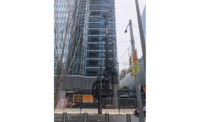FLEXLAB, for Plug 'n Play Green-Building Studies, Has World's First Revolving Test Bed


















For all the promise of rotation, Selkowitz's dream carousel almost died when Overaa's low bid of $10.3 million for the entire FLEXLAB came in $1.7 million over the $8.6-million budget estimate.
The turntable does not rotate 360˚ because the other sheds are to the east. Even so, the cost of 270˚ rotation is $1 million. That was "a real eye-opener" for the lab's scientists, says Richard Stanton, FLEXLAB's project director for the Berkeley lab's facilities group. "It is expensive to incorporate rotation into a permanent structure, meet seismic and safety codes, and deal with electrical feeds," he says.
After two months of value-engineering, including eliminating a static test bed and other elements, Overaa's price came down by $948,620 to an acceptable $9.4 million. The rotating test bed had survived the cuts. The lab issued a notice to proceed in June 2012.
Overaa's current contract, including add-ons, is at $9.8 million. The overall project is within budget, thanks to a contingency fund, says Ross Schaefer, FLEXLAB's project manager for the Berkeley lab.
The diminutive size and shed-like looks belie FLEXLAB's complexity. "We've had to overcome many technical challenges," says Schaefer.
The test cells are really science labs disguised as office space. "You couldn't use rules-of-thumb on this job because it was so different," says Tyler Disney, project engineer for ">Integral Group, the mechanical engineer. "You really had to examine every detail."
For example, the HVAC systems must have the precision and data-collection ability of scientific apparatus, but Integral had to specify off-the-shelf components. For an office building, chilled-water supply temperature to a radiant slab is within ±2˚ F of accuracy; for the lab, it has to be within ±0.5˚ F. Integral's workaround, to reduce the water temperature variation, was to specify a buffer tank.
Achieving plug-n-play capability has been especially difficult. "It took a lot of care, planning and meetings to understand the [special] details and more than the usual amount of coordination and cross-team communication," says Overaa's Blankinship.
Building information modeling would have helped, but it was a casualty of the value-engineering, he adds. Only the mechanical contractor used BIM.
The interface of the DAQ elements, especially with the HVAC controls, is a huge effort, says Schaefer. DAQ system designer ">Cal-Bay Systems, a provider of medical-device and other monitoring systems, had no experience with construction submittals. It took a while to work out an approvals process, he adds.
Still, the rotating test bed, not designed by the bid deadline, caused the greatest angst. In most so-called revolving buildings, only the floor rotates around a stationary core that contains utilities, says Stantec's Adams. The Berkeley building has no core.
Theory and experimentation go hand in hand. Thus a mock up needs to be supported by theory also ; for instance if the mock up isn't 100% faithful to the projected installation, theory m...
Theory is also a powerful guide for the detection of errors before they can cause grief in the installation Moreover theory can be cheap since it often involves no expensive test equipment with attendant worries of calibration, or overly complex software programs with attendant worry about bugs in the program.
A former chairman of the Nuclear Regulatory Commission nicely summarized how engineers are "wooed" with defective demonstrations with the illustration of
a contractor who throws a plank across a stream jumps on it 2 or 3 times and then proclaims it "safe'.
If the energy measurements show that the conservation of energy is being violated, it behooves the engineer to rely on the theory and not the measurements.

















